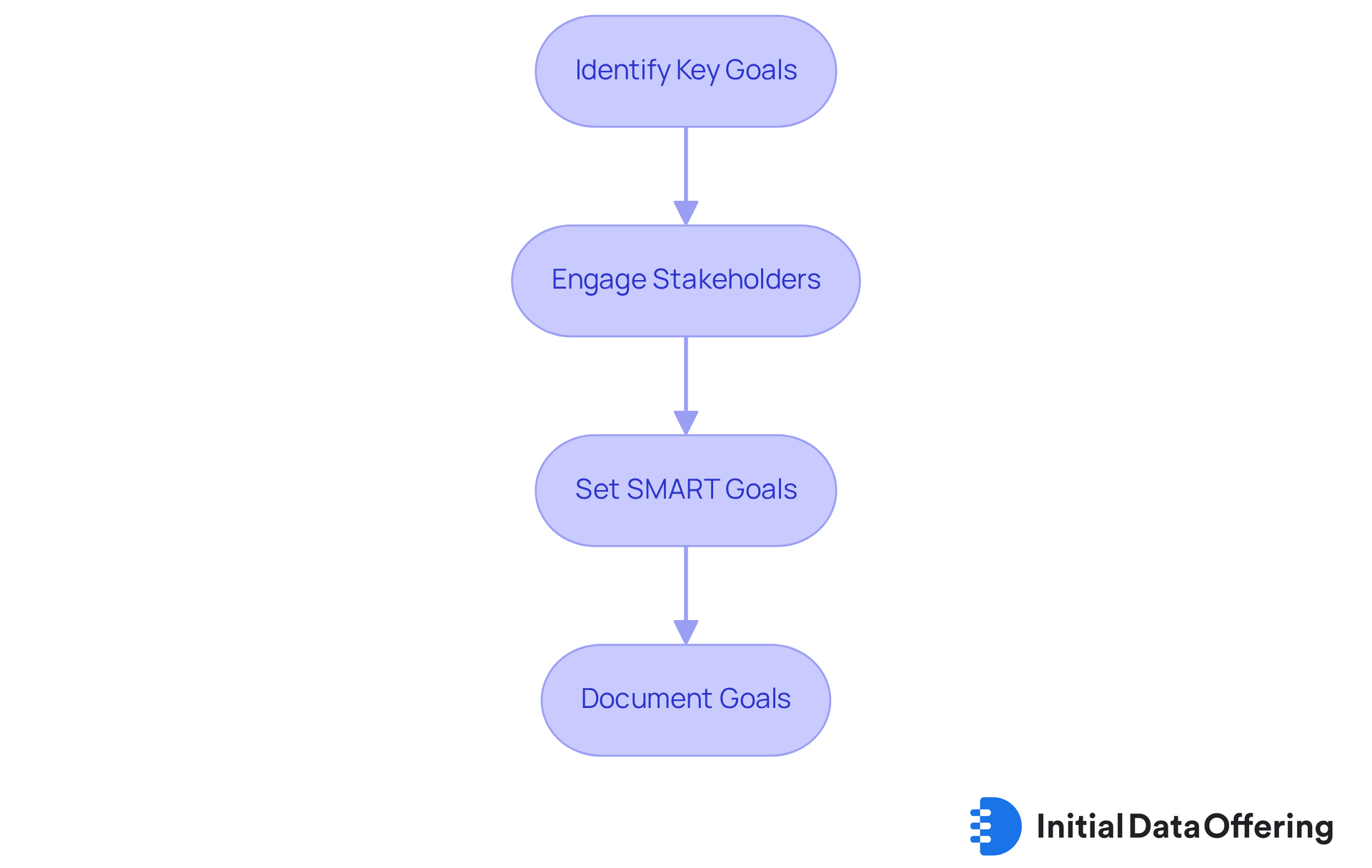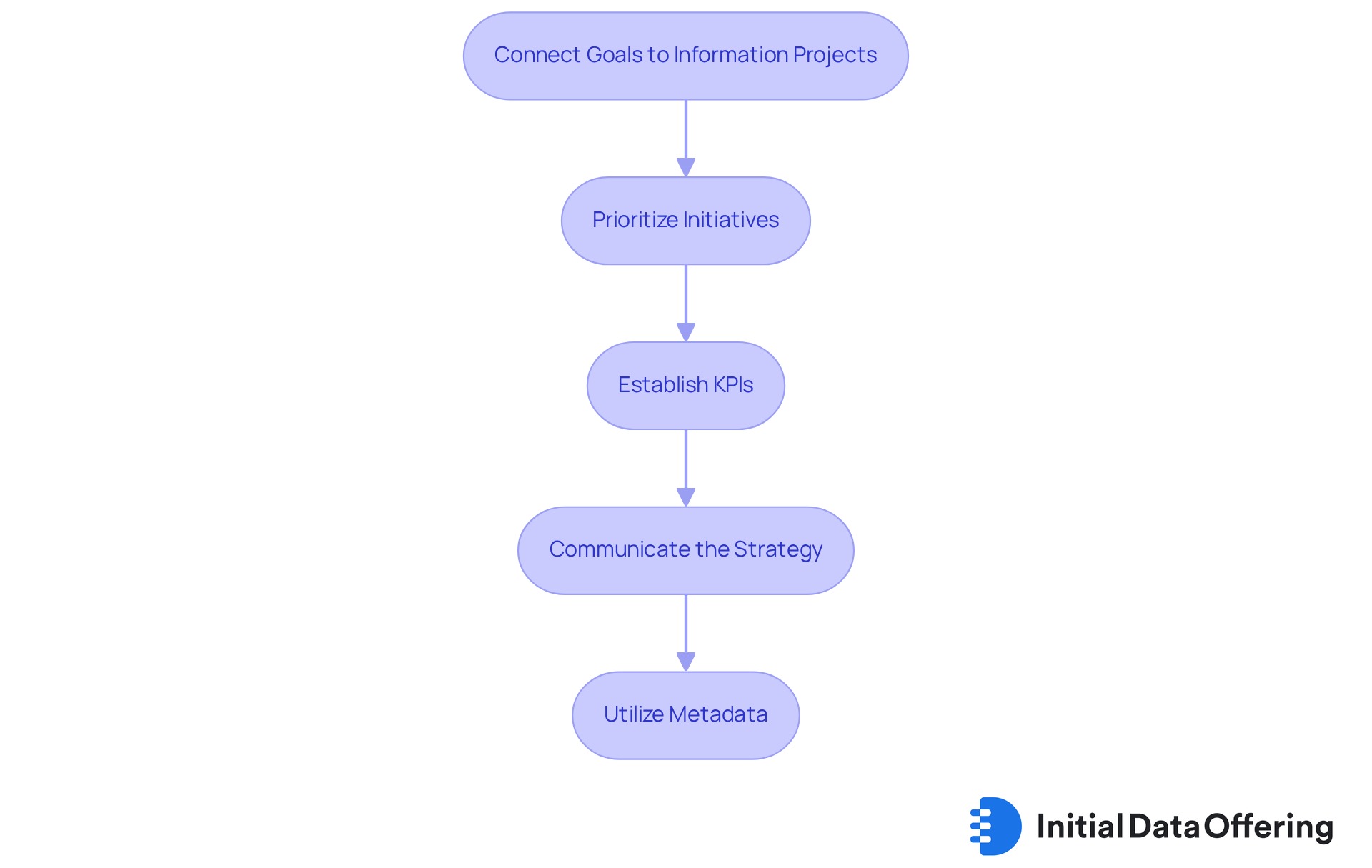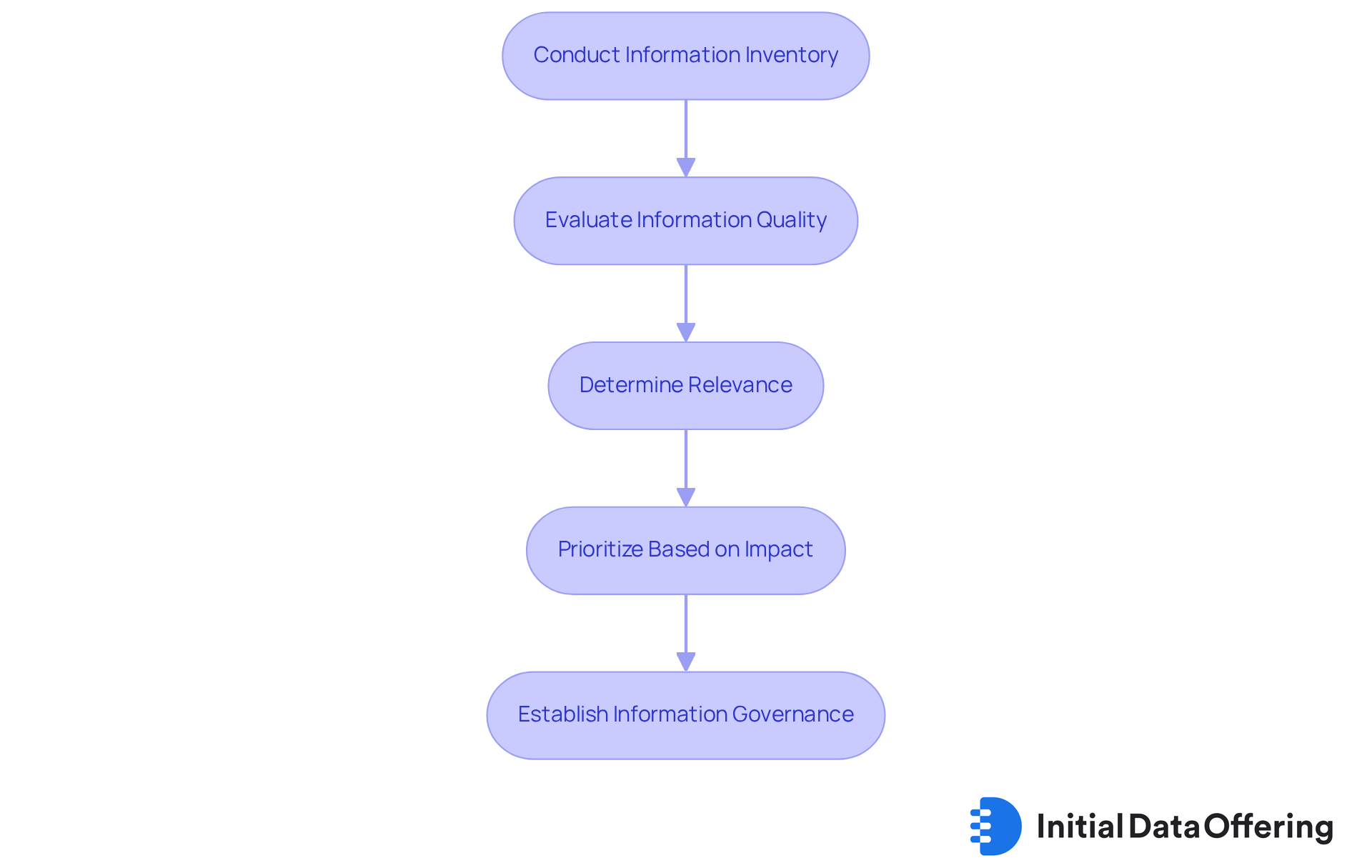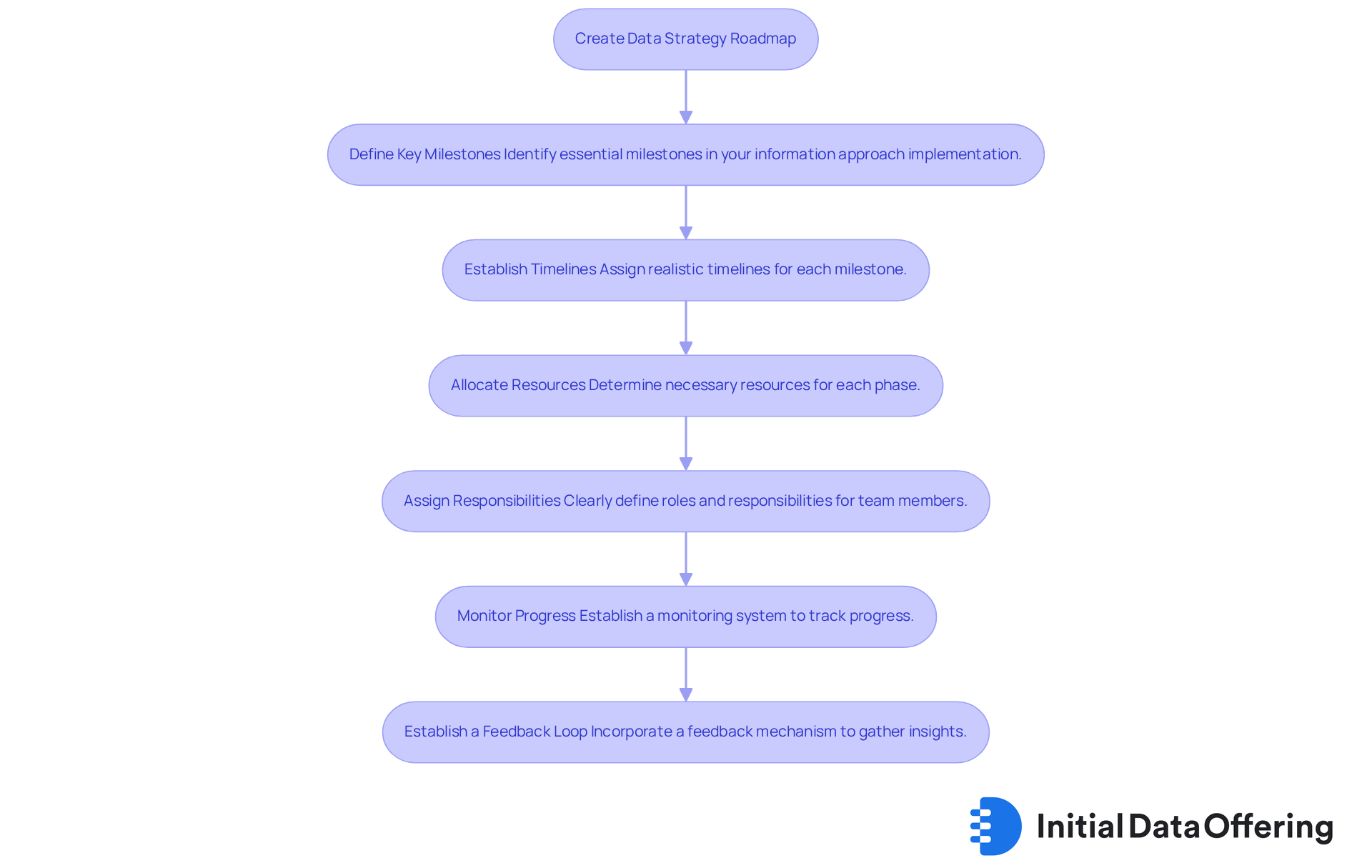Build Your Big Data Strategy: 4 Steps to Align with Goals

Build Your Big Data Strategy: 4 Steps to Align with Goals
Overview
The article outlines a four-step process designed to build a big data strategy that aligns seamlessly with organizational goals. This process includes:
- Defining business objectives
- Aligning the strategy with these goals
- Identifying and prioritizing data sources
- Creating a comprehensive roadmap for implementation
Each step underscores the critical importance of clear communication, stakeholder engagement, and data quality. These elements ensure that big data initiatives effectively contribute to achieving the organization's strategic aims.
By defining business objectives, organizations can clarify what they seek to accomplish with their big data efforts. This alignment not only guides the strategy but also enhances focus on relevant data sources. Identifying and prioritizing these sources allows organizations to leverage data that will have the most significant impact. Finally, creating a roadmap for implementation provides a structured approach to executing the strategy, ensuring that all stakeholders are on the same page.
In this context, consider how your organization can adopt this four-step process. What specific business objectives could guide your big data initiatives? How can prioritizing data sources improve your decision-making? By addressing these questions, organizations can enhance their big data strategies, ultimately leading to more effective outcomes and a stronger alignment with their strategic goals.
Introduction
Crafting a successful big data strategy is essential for organizations aiming to harness the power of data in a meaningful way. By aligning data initiatives with clear business objectives, companies can unlock insights that drive growth, enhance customer experiences, and streamline operations. However, the challenge lies in effectively translating these objectives into actionable steps that yield measurable results.
What are the key strategies to ensure that a big data approach not only supports but also propels an organization toward its goals? This question invites organizations to consider how they can leverage data effectively to achieve their aspirations.
Define Your Business Objectives for Big Data
To initiate the development of your extensive information strategy, begin by outlining your organizational goals. This foundational step is crucial for aligning your information approach with your enterprise ambitions. Consider the following steps:
- Identify key goals: What do you aim to achieve with your big data strategy? This may encompass enhancing customer insights, boosting operational efficiency, or driving revenue growth.
- Engage Stakeholders: How can you ensure a comprehensive understanding of business requirements? Involve key stakeholders from various departments to gather diverse viewpoints on your goals.
- Set SMART Goals: Are your aims Specific, Measurable, Achievable, Relevant, and Time-bound? For instance, instead of a vague 'increase sales', specify 'increase sales by 20% in the next quarter through targeted marketing campaigns'.
- Document Goals: Why is documentation important? Create a formal document detailing these aims to serve as a reference point throughout the planning development process.
By explicitly outlining your enterprise aims, you establish a plan that connects your information strategy with your organization's objectives. This connection guarantees that every initiative related to information contributes to your success.

Align Big Data Strategy with Business Goals
Aligning your big data strategy with established goals is crucial for maximizing impact. To achieve this alignment, consider the following key steps:
-
Connect Goals to Information Projects: Begin by creating a visual representation that links each corporate aim with related information initiatives. This mapping clarifies how specific information efforts can drive progress toward each goal, ensuring a focus on big data strategy. As Michael Porter states, "Strategy is about making choices, trade-offs; it’s about deliberately choosing to be different."
-
Prioritize Initiatives: Assess which information initiatives will most significantly impact your goals. Concentrate on high-impact projects that promise quick wins, thereby enhancing overall effectiveness and demonstrating immediate value. Research indicates that compliance (50%) and cost management (36%) are significant challenges that can limit the effectiveness of a big data strategy, making prioritization crucial.
-
Establish KPIs: Define Key Performance Indicators (KPIs) to evaluate the success of your information initiatives against organizational objectives. For example, if your goal is to enhance customer experience, relevant KPIs could include customer satisfaction scores or Net Promoter Scores (NPS). This organized approach is essential, as only 27% of organizations effectively align their big data strategy with corporate goals.
-
Communicate the Strategy: Distribute the coordinated plan to all stakeholders to foster a thorough understanding of how information initiatives support organizational goals. This communication is vital for cultivating a data-driven culture within the organization. Additionally, establishing a governance structure is crucial to ensure that initiatives related to the big data strategy are effectively aligned with business goals.
-
Utilize Metadata: Recognize the importance of metadata in providing context and tracking information lineage, which is essential for complying with privacy regulations and maintaining accountability. By efficiently aligning your goals with information projects, you ensure that your efforts are not only meaningful but also vital to the organization's overall success.

Identify and Prioritize Data Sources
To align your extensive information strategy with business goals, the next vital step is to identify and prioritize information sources. Here’s a structured approach:
-
Conduct an Information Inventory: Begin by compiling a comprehensive list of all potential information sources available to your organization. This includes internal databases, third-party providers, and public datasets, which serve as the foundation for your information strategy.
-
Evaluate Information Quality: Assess each source against key criteria such as accuracy, completeness, and timeliness. High-quality information is essential for producing trustworthy insights, as poor information quality can lead to misguided decisions. In fact, in 2025, organizations that emphasized quality information reported a 20% increase in decision-making efficiency. As Vipin Arora, Director of BEA, stated, "Data quality is the cornerstone of effective decision-making."
-
Determine Relevance: Identify which information sources align most closely with your organizational objectives. For instance, if your aim is to enhance customer insights, prioritize sources that provide comprehensive information on customer behavior. This relevance ensures that the data you gather directly supports your strategic goals.
-
Prioritize Based on Impact: Rank the information sources according to their potential influence on your business objectives. Focus on those that can deliver actionable insights and significantly impact decision-making processes. A case study on predictive maintenance illustrates how organizations can leverage information quality to anticipate market changes effectively.
-
Establish Information Governance: Implement robust governance practices to maintain quality and ensure compliance. This includes defining ownership, access rights, and management processes to safeguard data integrity. Effective governance is crucial, as highlighted in the AETC's strategy for connecting information standards and analytics.
By systematically recognizing and prioritizing information sources, you can establish a solid base for your information strategy. This ensures that it is rooted in high-quality, pertinent information, ultimately fostering informed decision-making.

Create a Data Strategy Roadmap
Developing an information framework roadmap is crucial for directing a large-scale information implementation. This roadmap serves as a structured strategy that aligns information initiatives with corporate aims. Here’s how to effectively create one:
-
Define Key Milestones: Identify essential milestones in your information approach implementation, such as information collection, analysis, and reporting phases. These milestones should indicate the value of each phase, ensuring they contribute to overall objectives.
-
Establish Timelines: Assign realistic timelines for each milestone. Research shows that information approach updates should occur at least every three months, with a minimum yearly assessment, to remain relevant and aligned with changing organizational needs (source: external research).
-
Allocate Resources: Determine the necessary resources for each phase, including personnel, technology, and budget. A carefully organized distribution of resources is essential; organizations with a clear information approach can attain 6% higher profits and 4% greater productivity. Additionally, analytics-driven entities outperform typical firms with 4% higher productivity.
-
Assign Responsibilities: Clearly define roles and responsibilities for team members involved in the implementation process. This fosters accountability and ensures that everyone understands their tasks, which is vital for maintaining momentum.
-
Monitor Progress: Establish a monitoring system to track progress against the roadmap. Regularly review milestones and adjust timelines or resources as needed to stay on track. Organizations that implement robust monitoring controls can more effectively react to competitive trends and ensure that their information approaches provide value.
-
Establish a Feedback Loop: Incorporate a feedback mechanism to gather insights from stakeholders and continuously improve the roadmap. This continuous improvement is essential for adapting to evolving market demands and ensuring the approach remains effective.
By creating a thorough big data strategy roadmap, you establish a clear direction for your organization, ensuring that all efforts align with business goals and that progress is quantifiable. This structured approach enhances the effectiveness of data initiatives and empowers your organization to leverage data for informed decision-making.

Conclusion
Establishing a robust big data strategy is essential for organizations aiming to achieve their business objectives. By clearly defining organizational goals and aligning data initiatives with these aims, companies can ensure that their big data efforts are not only relevant but also impactful. This alignment fosters a data-driven culture that enhances decision-making and drives success across various business functions.
Key steps in this process include:
- Identifying and prioritizing data sources
- Creating a structured roadmap
- Engaging stakeholders throughout the journey
Each of these elements plays a vital role in ensuring that data initiatives are effectively integrated into the overall business strategy. By focusing on high-quality information, setting measurable goals, and maintaining strong governance practices, organizations can navigate the complexities of big data and leverage it to meet their objectives.
Ultimately, the journey to building a successful big data strategy requires a commitment to continuous improvement and adaptability. As the landscape of data evolves, organizations must remain vigilant and responsive to change. By embracing these practices, businesses can unlock the full potential of their big data initiatives, driving innovation and achieving sustained growth in a competitive environment.
Frequently Asked Questions
What is the first step in developing a big data strategy?
The first step is to outline your organizational goals to align your information approach with your enterprise ambitions.
What should you consider when identifying key goals for your big data strategy?
You should consider what you aim to achieve with your big data strategy, such as enhancing customer insights, boosting operational efficiency, or driving revenue growth.
How can you ensure a comprehensive understanding of business requirements?
Engage key stakeholders from various departments to gather diverse viewpoints on your goals.
What does SMART stand for in goal setting?
SMART stands for Specific, Measurable, Achievable, Relevant, and Time-bound.
Why is it important to document your goals?
Documentation is important as it creates a formal reference point throughout the planning development process.
How does outlining enterprise aims benefit your information strategy?
By explicitly outlining your enterprise aims, you establish a plan that connects your information strategy with your organization's objectives, ensuring every initiative contributes to your success.